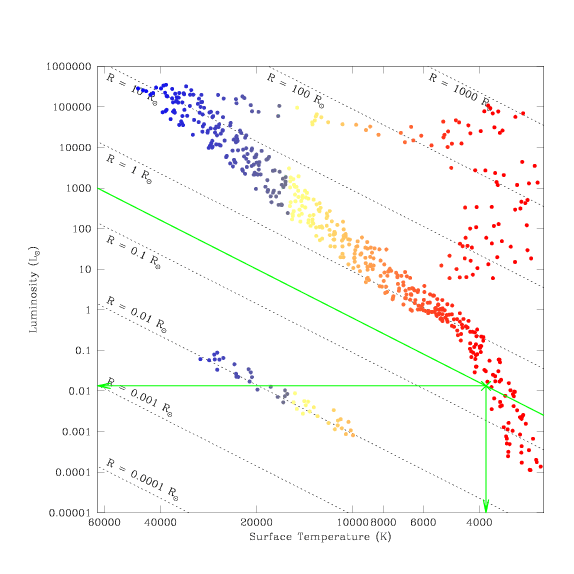 ), and a radius one-third that of the Sun (R
= 0.3 × R
), and a radius one-third that of the Sun (R
= 0.3 × R ).
This star lies along the Main Sequence, where most stars (including the Sun)
are found. The low temperature indicates quite red colours.
).
This star lies along the Main Sequence, where most stars (including the Sun)
are found. The low temperature indicates quite red colours.
What kind of stars are found here?
A star in this region of the Hertzsprung-Russell diagram has a temperature of
roughly 4,000 Kelvin (4,000 K), a luminosity one hundred times fainter than
that of the Sun (0.01 × L ), and a radius one-third that of the Sun (R
= 0.3 × R
), and a radius one-third that of the Sun (R
= 0.3 × R ).
This star lies along the Main Sequence, where most stars (including the Sun)
are found. The low temperature indicates quite red colours.
).
This star lies along the Main Sequence, where most stars (including the Sun)
are found. The low temperature indicates quite red colours.
Try to read the values of L, T, and R for yourself from the diagram. Do you estimate values for the luminosity, temperature, and size of the star similar to those listed above?

The key to understanding this property is to realize that there are families (groups) of straight lines running along and across the Hertzsprung-Russell diagram, which define all the locations in the diagram where stars have a shared property.
 . (This includes a number of white dwarfs, as well as a narrow band
along the Main Sequence.)
. (This includes a number of white dwarfs, as well as a narrow band
along the Main Sequence.)
 . (This includes a few super giants and
white dwarfs, as well as a narrow band along the Main Sequence.)
. (This includes a few super giants and
white dwarfs, as well as a narrow band along the Main Sequence.)
How can we use this narrow distribution to estimate the radii of a Main Sequence star from the luminosity L alone?
Consider the case of a Main Sequence star, with a luminosity just over
one-hundredth that of the Sun. We will use the Hertzsprung-Russell diagram to
estimate its radius R.
Following the horizontal green line draw over from 0.013 on the y-axis, we see
that a few red-coloured Main Sequence stars lie along it (we include all of
the red-coloured stars which lie just above and just below the green cross).
These are all the Main Sequence stars which have a luminosity of 0.013 L .
These stars are all related to one another in physical size. As stated above,
diagonal lines drawn on the diagram represent the locations of stars all of
the same size. Main Sequence stars with a luminosity of 0.013 L
.
These stars are all related to one another in physical size. As stated above,
diagonal lines drawn on the diagram represent the locations of stars all of
the same size. Main Sequence stars with a luminosity of 0.013 L thus
extend over only a small range in radius.
thus
extend over only a small range in radius.
Examine the Hertzsprung-Russell yourself, to estimate which two diagonal lines
would best bound the location of these Main Sequence stars.
These stars all lie below the line showing the location of all stars with the
same radius as the Sun, and they lie above the the line showing the location
of all stars with a radius ten times smaller than that of the Sun. It is easy
to see that all Main Sequence stars with a luminosity of 0.013 L have a radius between one-tenth and one times that of the
Sun – but we can do better!
have a radius between one-tenth and one times that of the
Sun – but we can do better!
To keep the diagram easy to read, we have drawn lines of constant radius at the radius of the Sun, at ten times the radius of the Sun, at one hundred times the radius of the Sun, and such, marking only powers of ten. However, we could as easily draw a line of constant radius at twice the radius of the Sun, or two-hundred times the radius of the Sun, or at any other size scale.
With your mind, fill in the region between the diagonal line at one solar
radius and the diagonal line at one-tenth solar radii with additional lines,
all parallel to the two found on the diagram. These lines will mark the
location of stars which are nine-tenth as large as the Sun, eight-tenth times
as large as the Sun, seven-tenth times as large as the Sun, and such, down to
two-tenths (one-fifth) the size of the Sun.
You can use your powers of observation to see that the Main Sequence stars
with a luminosity of 0.013 L will all lie above the line where stars are
two-tenths as large as the Sun, and below the line where stars are half as
large as the Sun.
will all lie above the line where stars are
two-tenths as large as the Sun, and below the line where stars are half as
large as the Sun.
We have accomplished a great deal with a small amount of information! Using only the luminosity of a star and the fact that it lies on the Main Sequence, we have limited its radius to between one-fifth and one-half that of the Sun.